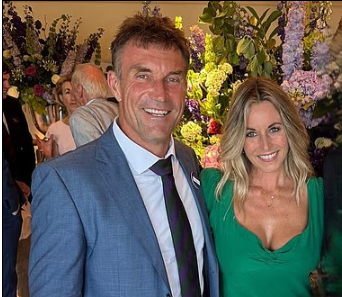Pat Cash’s attendance at Wimbledon in recent weeks attracted attention once more, but not because of his legendary baseline returns or commentary. He was accompanied by Charlotte Hodson, a 53-year-old massage therapist and singer who has significantly impacted Cash’s life on both a personal and professional level. Their relationship, which began in 2023 when they worked together with American tennis player Kayla Day, has grown to be especially significant. Given the public context of Wimbledon, a location that has long been associated with Cash’s past, this development felt particularly poignant.
The couple, who tour as “The Pat Cash Experience,” combines live performances by Hodson’s band, Chocolate Charlie, with tennis storytelling. Their performance has been characterized as especially inventive, combining music, emotional fortitude, and physical stamina in an unexpectedly captivating way. The way some retired athletes, such as Venus Williams, have expanded their narratives beyond tennis through fashion or wellness feels remarkably similar.
Pat Cash – Profile Table
| Attribute | Details |
|---|---|
| Full Name | Patrick Hart Cash |
| Nickname | Pat Cash |
| Date of Birth | May 27, 1965 |
| Age | 60 |
| Birthplace | Melbourne, Australia |
| Residence | London, England |
| Height | 1.83 m (6 ft) |
| Career-High Ranking | Singles No. 4 (1988), Doubles No. 6 (1988) |
| Major Title | Wimbledon Champion (1987) |
| Turned Pro | 1982 |
| Retired | 1997 (Singles), 2006 (Doubles) |
| Prize Money | $1,950,345 |
| Partner | Charlotte Hodson (Singer & Massage Therapist) |
| Reference |
Pat’s remarks regarding Charlotte in a recent interview with The Mirror struck me as particularly explicit: “I don’t know if we’ll go down the marriage route, but she’s the love of my life.” With maturity and candor, Cash has embraced this new chapter at the age of 60, enabling his audience to witness not only a Wimbledon champion but also a man striking a balance between love and legacy.
Even though it isn’t as well-known, his romantic past is complex. In his early twenties, Cash and Norwegian model Anne-Britt Kristiansen had two kids. He later married Brazilian Emily Bendit from 1990 to 2002, and the two of them have twin sons. He reportedly embraced his role as a grandfather with quiet pride, having already assumed it by the time he was 45. Because of these experiences, which have been layered over time, Cash has a particularly complex story that is characterized by survival and growth rather than straightforward success.
Cash openly admitted to The Guardian in 2014 that he experienced severe depression from the ages of 19 to 35. He acknowledged, “I might have killed myself if it weren’t for my kids.” The extreme pressure that top athletes, especially those who represent their nation, face was highlighted by that unvarnished honesty. Retirement and therapy helped him eventually recover, and this has become a common theme in many of his post-career endeavors.
Cash has discovered an incredibly successful method to turn his past into something forward-looking by working with Charlotte. Their performances combine music, memory, and tennis technique to create living archives rather than merely nostalgic celebrations. The experience gives viewers a glimpse into the intricacies of aging with purpose, which is something that is exclusively human.
Although Cash has received praise for his emotional comeback, he hasn’t held back from igniting controversy. In 2021, he controversially recommended Ivermectin as a prophylactic measure against COVID-19 in an interview with The Conservative Woman. Despite receiving a lot of criticism, his position put him in line with other outlier athletes, such as surfer Kelly Slater, with whom he later discussed ideas for urban planning like the 15-minute city. Due in part to the sincere love that tennis fans have for him as a legend, these remarks drew criticism but did not undermine his wider appeal.
Particularly well received was Cash’s return to the BBC commentary box at Wimbledon in 2025. His decades-of-experience-shaped insights seemed incredibly effective, communicating intricate tactical analysis with a deftness that few commentators can match. Cash keeps redefining what longevity in sports media can look like at a time when many retired athletes are avoiding the limelight.
Cash has created a path that is not only robust but also noticeably better through strategic alliances and a constantly changing public image. The addition of Charlotte Hodson has given this development more coziness and inventiveness. She is more than just a friend; she is a collaborator whose impact goes beyond romance to the professional and creative rhythms of Cash’s everyday existence.
In addition to revitalizing his brand, their tour has given tennis fans a new way to interact with the sport’s past. In many respects, Cash’s own journey—one characterized by extremes, from the pinnacle of athletic glory to the depths of personal struggle—is reflected in these intimate performances. Audiences find a great deal of emotional resonance in the fact that he now shares this space with the person he refers to as the love of his life.
Stories like Pat Cash’s serve as especially helpful reminders that success is rarely linear, and society has grown more sensitive to the emotional health of athletes in recent years. Cash adds to a larger conversation that promotes vulnerability and support, particularly among men over 50, by disclosing his struggles with depression and his sluggish journey toward emotional stability.
With her training in holistic wellness and music therapy, Charlotte is more than just a romantic partner. She represents a change in which athletes actively look for creative fulfillment and balance in unusual ways. Accordingly, their collaboration exemplifies a larger movement in which public storytelling and personal healing come together to produce stories that are both uplifting and desperately needed.

